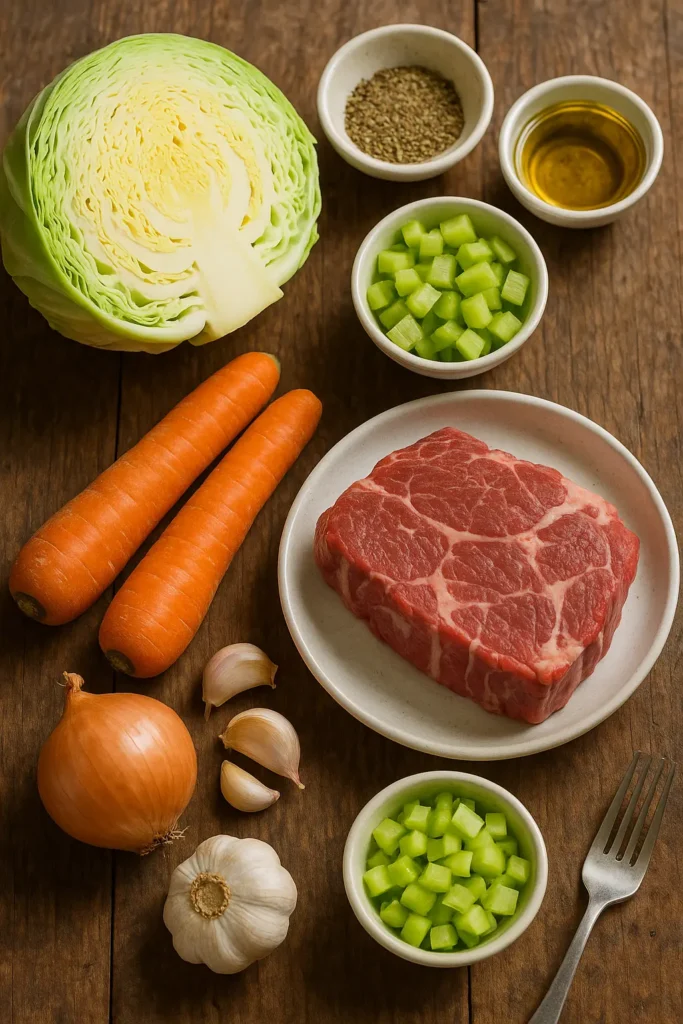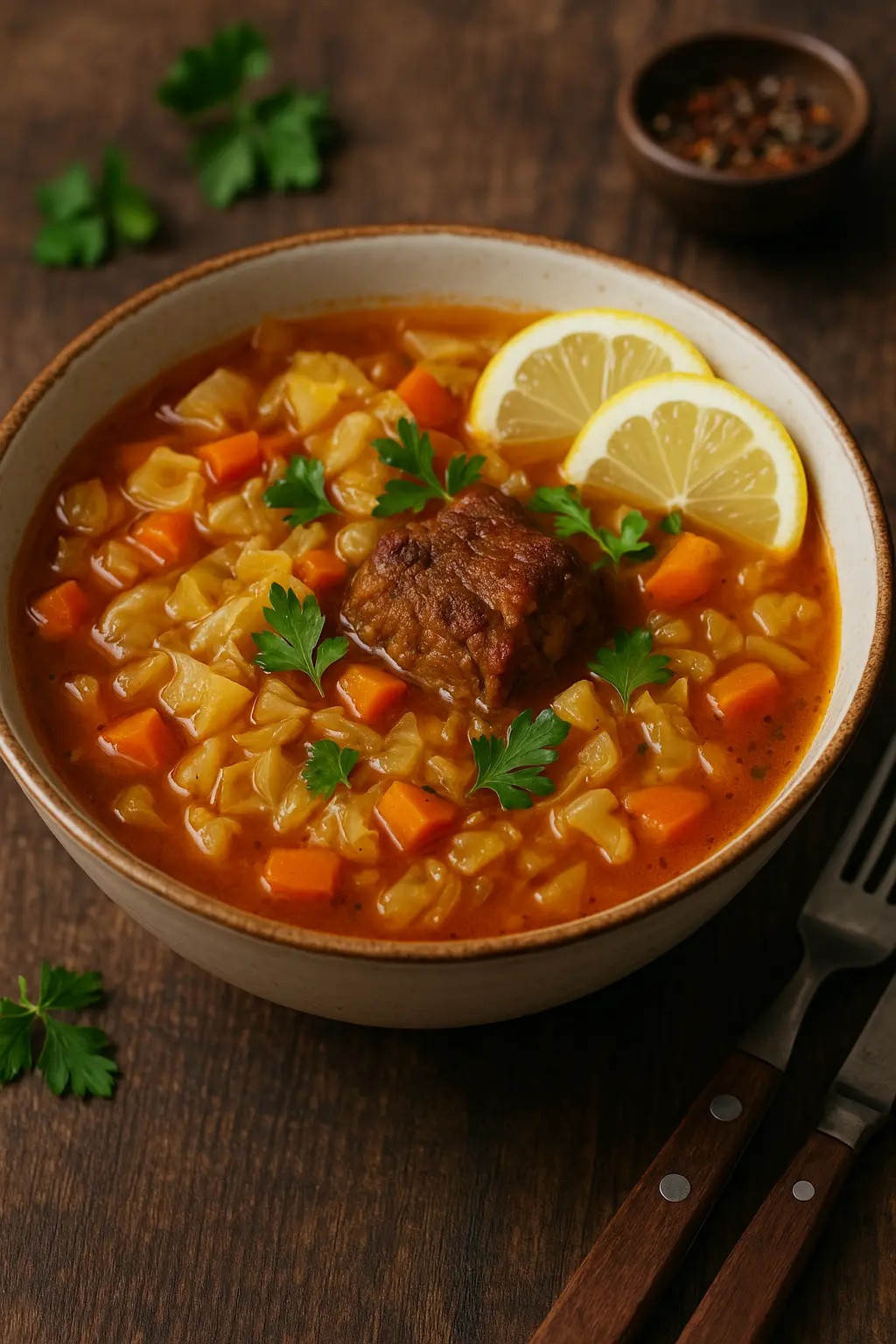Think cabbage soup is bland, boring, and only good for crash diets? Think again. According to Google Trends, interest in cabbage soup has surged by over 40% in the past two years, driven by a growing demand for comfort food that is also healthy and budget-friendly. But here’s the twist: while cabbage soup is known for being simple and nutritious, most people still struggle to make it taste truly amazing.
If you’ve ever asked, “How can I make cabbage soup actually taste good?” — you’re not alone. This post dives into everything you need to know to master the art of delicious, hearty cabbage soup, from bold ingredient swaps to pro-level cooking tips.
Table of Contents
Ingredients List

Here’s what you’ll need for a flavor-packed cabbage soup:
- 1 medium green cabbage, chopped
- 2 tablespoons olive oil
- 1 large yellow onion, diced
- 3 cloves garlic, minced
- 3 carrots, sliced
- 2 celery stalks, chopped
- 1 bell pepper (red or yellow), chopped
- 1 zucchini, sliced (optional)
- 6 cups vegetable or chicken broth (low-sodium)
- 1 can (14.5 oz) diced tomatoes
- 1 tablespoon tomato paste
- 1 teaspoon smoked paprika
- 1/2 teaspoon dried thyme
- 1/2 teaspoon black pepper
- Salt to taste
- 1/4 teaspoon red pepper flakes (optional, for heat)
- 1 tablespoon apple cider vinegar (for brightness)
- Fresh parsley or dill for garnish
Substitutions:
- Swap olive oil with avocado oil for a richer taste.
- Replace diced tomatoes with fire-roasted tomatoes for deeper flavor.
- Use bone broth instead of vegetable broth for added nutrients and umami.
Timing
- Prep Time: 15 minutes
- Cook Time: 35 minutes
- Total Time: 50 minutes
This cabbage soup comes together in under an hour — that’s 20% faster than many traditional slow-simmer recipes, making it perfect for busy weeknights.
Step-by-Step Instructions
Step 1: Sauté the Aromatics
Heat olive oil in a large pot over medium heat. Add onions, carrots, and celery. Cook for 5-6 minutes until softened. Stir in garlic and cook for 1 more minute.
Tip: Let the onions caramelize slightly to deepen the flavor base.
Step 2: Build the Flavor
Add bell pepper, zucchini (if using), tomato paste, paprika, thyme, pepper, and red pepper flakes. Cook for another 2-3 minutes, stirring to coat the veggies.
Step 3: Add Liquids and Cabbage
Pour in broth, diced tomatoes, and chopped cabbage. Stir well and bring to a boil. Reduce heat and let simmer uncovered for 25-30 minutes until cabbage is tender.
Tip: Don’t overcook the cabbage — aim for tender, not mushy.
Step 4: Finish and Adjust
Stir in apple cider vinegar. Taste and adjust seasoning. Add salt as needed and more pepper if desired.
Step 5: Serve and Garnish
Ladle into bowls and top with fresh parsley or dill. Serve hot with crusty bread or a scoop of cooked quinoa.
Nutritional Information
A single 1.5-cup serving contains approximately:
- Calories: 110
- Protein: 4g
- Fat: 4g
- Carbohydrates: 15g
- Fiber: 5g
- Sodium: 480mg (varies by broth)
Cabbage is rich in vitamins K and C, and this soup delivers high fiber with low calories — perfect for anyone watching their weight or improving digestion.
Healthier Alternatives for the Recipe
- Low-Carb Option: Skip carrots and use cauliflower for fewer carbs.
- Protein Boost: Add lean ground turkey or white beans.
- Vegan Version: Stick with veggie broth and avoid any dairy-based garnishes.
- Anti-inflammatory Twist: Add turmeric and swap black pepper for white pepper.
These variations keep cabbage soup nutritious while adapting it to keto, paleo, or plant-based diets.
Serving Suggestions
- Pair with a slice of whole grain bread or a grilled cheese sandwich.
- Top with a spoonful of Greek yogurt or vegan sour cream.
- Serve with a drizzle of pesto or a splash of hot sauce.
Personal Tip: Leftovers make a great base for stir-fry or grain bowls the next day. Just strain out some broth and mix with rice or couscous.
Common Mistakes to Avoid
- Overcooking the Cabbage: Leads to a soggy texture and sulfur smell.
- Skipping the Acid: Apple cider vinegar or lemon juice brightens the flavor.
- Using Bland Broth: Choose a broth with body and seasoning.
- Forgetting to Taste as You Go: Adjust salt and spices progressively.
Storing Tips for the Recipe
- Refrigerate: Store in an airtight container for up to 5 days.
- Freeze: Freeze in portion-sized containers for up to 2 months.
- Meal Prep Tip: Chop vegetables in advance and freeze in a zip bag; dump into a pot with broth when ready to cook.
Reheating tip: Warm gently on the stovetop to preserve texture and flavor.
Conclusion
Cabbage soup is more than a diet fad — it’s a versatile, nourishing dish that can be as flavorful as your favorite stew. With the right ingredients and smart techniques, you can turn a humble pot of cabbage soup into a crave-worthy comfort meal.
Ready to try your new favorite soup? Make it tonight, and let us know how it turned out! Don’t forget to explore more cozy recipes in our soup collection.
FAQs
1. Can I make cabbage soup in a slow cooker?
Yes! Sauté the aromatics first, then add everything to your slow cooker and cook on low for 6-8 hours.
2. Is cabbage soup good for weight loss?
Yes. It’s low in calories, high in fiber, and can support a calorie-controlled diet.
3. How can I make cabbage soup spicier?
Add more red pepper flakes, cayenne, or stir in a spoon of harissa paste.
4. Can I freeze cabbage soup?
Absolutely. Let it cool, portion it out, and freeze for up to 2 months.
5. Why does my cabbage soup taste bitter?
Overcooked cabbage or low-quality broth can cause bitterness. Use fresh cabbage and well-seasoned broth, and don’t skip the acid.

